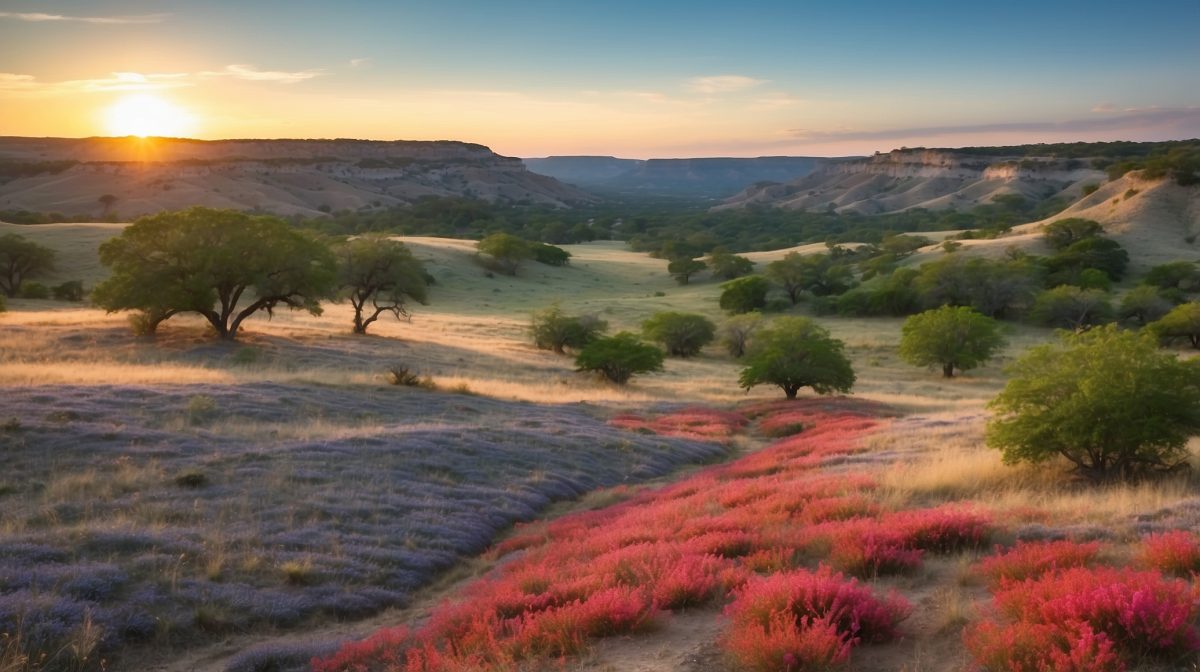As a fella who’s spent his fair share of time wanderin’ these parts, I’ve got a deep-seated love for the history etched into every hill and valley. Today, I’m fixin’ to take y’all on a journey through the makin’ of this beautiful land. So, buckle up, partner, we’re about to explore how the Texas Hill Country came to be.
The Geological Roots of Texas Hill Country
Let’s mosey on back to a time when dinosaurs roamed and the earth was a whole different ball game. We’re talkin’ about geologic eras that’ll make your head spin – millions upon millions of years that shaped the ground beneath our boots. The Texas Hill Country’s story starts way back then, and it’s as fascinatin’ as a tall tale by the campfire.
Now, imagine the earth’s crust gettin’ all riled up, with plates shiftin’ and movin’ like a two-step dance. That’s the kind of tectonic hoedown that gave us the uplifts and folds responsible for the Hill Country’s signature topography. And let’s not forget the limestone and granite that laid the foundation – it’s the bedrock of our beloved hills.
Erosion: Nature’s Sculptor
When Mother Nature gets to work with her tools – water, wind, and time – she can carve out some mighty fine art. The rolling hills we know and love? They’re the result of years of her chiselin’ and shapin’. It’s a slow process, but the end result is worth the wait, trust me.
And let’s tip our hats to the rivers and streams that have been busily cuttin’ through the land, creatin’ valleys and exposin’ hidden geological treasures. It’s these waterways that have been the master sculptors of the Texas Hill Country, givin’ it the character and curves we admire today.
The Ice Age Touch
Y’all might not reckon glaciers had much to do with Texas, but back during the Ice Age, they sure left their mark on the Hill Country. While they didn’t roll through these parts, the cooler temps and changin’ climate had a big ol’ impact on the land, from the topography to the critters wanderin’ around.
And speakin’ of critters, the Ice Age saw a whole mess of flora and fauna migration, with species comin’ and goin’ as the climate dictated. Even today, you can find traces of these ancient changes in the Hill Country, tellin’ stories of a time long gone.
Human Influence on the Landscape
Long before cowboys and cattle drives, the Native Americans knew this land like the back of their hand. They lived in harmony with the Hill Country, leavin’ behind a legacy that’s as rich as Texas soil. Their connection to the land is a powerful chapter in our history.
Then came the European settlers, bringin’ with ’em a whole new way of life and a new chapter in the Hill Country’s tale. From ranches to farms, the landscape began to change. But don’t you worry – nowadays, there’s a strong push for conservation to keep the spirit of the Texas Hill Country as wild and free as it oughta be.
The Wonders of the Texas Hill Country Today
Now, the Texas Hill Country ain’t just a pretty face; it’s a treasure trove of natural wonders. We’re talkin’ caves that’ll leave you speechless, wildflowers that paint the countryside, and wildlife that reminds you this is still a bit of untamed Texas. It’s the kind of place that’ll fill your heart and clear your mind.
And if you’re the outdoorsy type, you’re in for a treat. With trails to hike, rivers to fish, and game to hunt, there’s no shortage of ways to soak in the beauty of the Hill Country. Plus, the charm of our towns and communities is as warm as a Texas sunset, y’all.
Conclusion
As we saddle up and ride off into the sunset of this here tale, it’s clear that the Texas Hill Country’s beauty is the result of a whole tapestry of natural events. From geological shifts to the gentle touch of erosion, every element has played its part in shapin’ this land we hold dear.
It’s up to us, the proud Texans, to honor and maintain the heritage of the Hill Country. Whether we’re conservin’ the land or passin’ down the stories, each of us has a role in keepin’ the spirit of this place alive for generations to come. So let’s tip our hats to the past and work towards a future where the Texas Hill Country remains as wild and wonderful as ever.
FAQs
What’s the oldest geological formation in the Texas Hill Country?
The Llano Uplift is the heart of the oldest rock formations in the Texas Hill Country, some datin’ back over a billion years, if you can believe it.
How have the rivers and streams shaped the Texas Hill Country over the years?
Rivers and streams have carved out the valleys and canyons, sculptin’ the landscape into the rollin’ hills and rocky outcrops we cherish today.
Can you find dinosaur fossils in Texas Hill Country?
You betcha! Dinosaur tracks and fossils have been found in several spots, leavin’ their ancient footprints for us to marvel at.
How did the Ice Age affect the flora and fauna of the Texas Hill Country?
The cooler climates of the Ice Age led to changes in vegetation and encouraged different animals to migrate to and from the area, leavin’ behind a diverse ecological history.
What are some of the best ways to experience the natural beauty of the Texas Hill Country?
From explorin’ the vast network of caves to takin’ a wildflower tour, hikin’, fishin’, and enjoyin’ the local wildlife, there’s no shortage of ways to immerse yourself in the Hill Country’s natural splendor.


